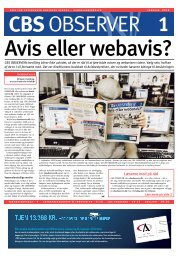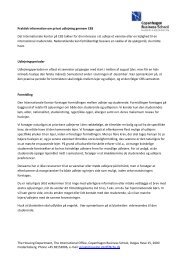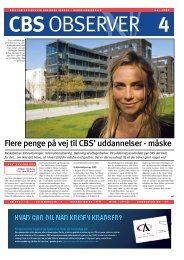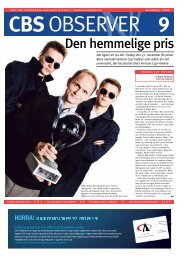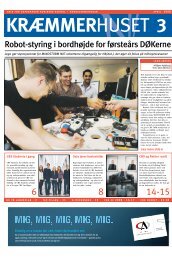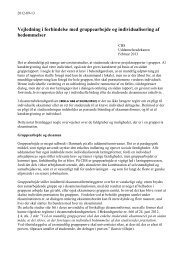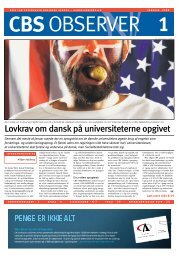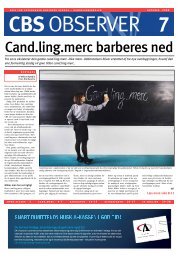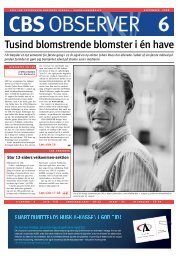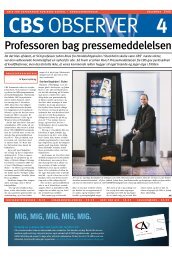Untitled - CBS Observer
Untitled - CBS Observer
Untitled - CBS Observer
Create successful ePaper yourself
Turn your PDF publications into a flip-book with our unique Google optimized e-Paper software.
Introduction<br />
It was a cold morning in February 2013. Jesper Møller, the CEO of Toms Confectionery Group, was look-<br />
ing down at the frozen fountain in the courtyard by Toms’ headquarters outside Copenhagen. Designed in<br />
1962 by the famous Danish architect Arne Jacobsen, the headquarters, like the company, was an iconic<br />
piece of Danish history. For decades, Toms had been a Danish household name and local market leader<br />
within the confectionery industry. Today, however, it was time to look ahead.<br />
Toms, like most other companies, had gone through the<br />
financial crisis with a solid focus on the cost base. How-<br />
ever, as a small player in the global confectionery industry,<br />
the company could only go so far with cost cutting alone.<br />
Instead, Toms needed to make a thorough analysis to capture<br />
the opportunities that lay ahead. That morning, Møller had<br />
called together his management team to discuss Toms’ fiveyear<br />
strategy for the chocolate confectionery business under<br />
the following headline:<br />
How should Toms profitably grow its<br />
chocolate confectionery business?<br />
Toms’ ambition was to find focused growth as a strong niche<br />
player. Until 2012, the Danish market had accounted for<br />
almost 60 percent of Toms’ revenues. But Denmark is a mature,<br />
price-competitive market with heavy excise taxes on confectionery<br />
products. Møller and his team feared that the Danish<br />
market would become increasingly unattractive for chocolate<br />
confectionery manufacturers. Instead, Møller was confident<br />
that other attractive opportunities existed.<br />
In the spring of 2012, Toms took a significant step forward<br />
by acquiring the German chocolate company Hanseatische<br />
Chocolade GmbH. Overnight, Toms added sales of 360 million<br />
Danish kroner. However, the management team agreed<br />
that this was only the first step in Toms’ path.<br />
As Møller and the management team watched the day’s first<br />
truckload of cocoa beans approach the factory loading dock,<br />
they began reflecting on the past, present and future of Toms<br />
as a chocolate confectionery company.<br />
2 <strong>CBS</strong> CASE COMPETITION 2013<br />
3
Company overview<br />
The history of Toms<br />
Confectionery Group<br />
Two Danish chemists named H. Trojel and V.H Meyer founded<br />
what was to become the Toms Confectionery Group in<br />
1924, when they started producing candy and sweets in humble<br />
settings on the island of Amager, just outside Copenhagen.<br />
They named the company Tom, an acronym for Trojel<br />
Og (and) Meyer. However, the name Tom was easily confused<br />
with the Danish word for “empty”, which is spelled the same<br />
way. Since this turned out to be an unfortunate association for<br />
a company that primarily sold its products through vending<br />
machines, they decided to change the name slightly to Toms.<br />
The development of the company took off after World War<br />
II when local entrepreneur and businessman Victor B. Strand<br />
acquired Toms, which at that point was a small-scale local<br />
chocolate and confectionery producer. Via a range of mergers<br />
and acquisitions in Denmark – most notably those of the<br />
chocolate producer Anthon Berg in 1954 and the confectionery<br />
company Galle & Jessen in 1971 – Strand built a national<br />
chocolate and confectionery powerhouse. In 1950, Toms was<br />
appointed the distinguished title “Purveyor to the royal Danish<br />
court”, which allowed the company to use the image of<br />
the royal crown on its products. In 1961, the company moved<br />
into its new headquarters in Ballerup outside Copenhagen<br />
and combined the majority of its production under one roof.<br />
During the 1990s, Toms expanded its operations abroad<br />
when it tried to gain access to the UK market by acquiring the<br />
candy company Taveners and the chocolate producer Daintee<br />
Chocolate. However, the international venture proved<br />
unsuccessful, and the UK business was divested soon after<br />
Jesper Møller became Toms’ CEO in 2006.<br />
Today, Toms is owned entirely by the Gerda & Victor B.<br />
Strands foundation, which was established in 1974. The ownership<br />
form gives Toms’ management considerable freedom<br />
to focus on the long-term development of the company.<br />
Toms today<br />
Toms is engaged in the development, production and sales of<br />
high-quality chocolate and sugar confectionery products. The<br />
company employs approximately 1,200 people, depending<br />
on the season. Toms is organized in a functional structure,<br />
with central administration at the company headquarters in<br />
Ballerup, Denmark. Most tasks pertaining to the overall strategy<br />
are coordinated from the company headquarters, where<br />
the majority of the administrative employees reside. Production,<br />
on the other hand, is decentralized in five different locations,<br />
with each factory specializing in a different area of<br />
expertise.<br />
Toms’ turnover distribution by market<br />
Foundation ownership<br />
Rule number one in traditional management literature is<br />
that management exists to serve the interests of shareholders.<br />
Foundation ownership, at the very least, stretches that<br />
rule. Foundations primarily seek to ensure the long-term<br />
development of their companies, since foundations have<br />
no shareholders and no dividend requirements. Foundation-owned<br />
companies rely fully on their management and<br />
foundation board members to control the direction of the<br />
company. As a result, many of the traditional corporate governance<br />
models do not apply to foundation ownership. In<br />
addition, foundation-owned companies are entirely protected<br />
against hostile takeover attempts.<br />
The prevalence of the foundation ownership form is a<br />
unique feature of the Danish business environment. Approximately<br />
20 percent of business activity in Denmark is<br />
The Danish market remains Toms’ primary market and the<br />
company generates approximately half of its total revenue<br />
here. With a total market share of approximately 30 percent,<br />
Toms is a clear market leader within the chocolate category<br />
in Denmark. It carries a significant lead over its closest rival,<br />
Mondelez International (the former snack foods division of<br />
Kraft), who controls around 15 percent.<br />
On an international scale, however, Toms is a very small player.<br />
The company ranks around number 50 among the world’s<br />
confectionery companies. Despite this limited international<br />
presence, Toms holds a relatively strong position in the global<br />
travel retail and duty-free segment. Within this niche area, the<br />
company holds a market position as approximately number<br />
seven when measured in volume.<br />
50 % Denmark<br />
15 % Sweden<br />
15 % Germany<br />
10 % Travel retail EU<br />
10 % Exports<br />
1 % Travel retail Far East Asia and Americas<br />
Note: percentages may not total 100 due to rounding<br />
carried out by foundation-owned companies. In fact, many<br />
of the most prominent Danish companies – Lego, Maersk,<br />
Carlsberg, Novo Nordisk and many more – are controlled<br />
by foundations.<br />
The sole purpose of Toms’ owner, the Gerda & Victor B.<br />
Strands foundation, is to ensure the future survival and development<br />
of Toms Confectionery Group in a sound and<br />
profitable manner. As such, the foundation sets no boundaries<br />
on business decisions that live up to this criterion. No<br />
members of the Strand family are active in the foundation<br />
or company today, and the board consists entirely of business<br />
professionals and lawyers. As of 2012, the foundation<br />
has a cash base of approximately 200 million Danish kroner<br />
and, as a result, the Toms Group as a whole is nearly debtfree.<br />
4 <strong>CBS</strong> CASE COMPETITION 2013<br />
5<br />
15%<br />
10%<br />
15%<br />
10%<br />
1%<br />
50%
“<br />
Product portfolio<br />
As a result of several mergers and acquisitions, Toms Confectionery<br />
Group has built a comprehensive product range and<br />
brand portfolio in chocolate and sugar confectionery products.<br />
The majority of Toms’ revenue comes from its chocolate<br />
confectionery products, where its extensive portfolio gives<br />
the company exposure to virtually all consumer segments.<br />
The diverse portfolio of non-chocolate confectionery products<br />
allows Toms to mitigate the seasonal factors that tend<br />
to affect manufacturers who exclusively produce chocolate.<br />
Since sugary products have a more stable demand, they help<br />
to even out earnings across the year.<br />
Toms has traditionally had a broad product<br />
portfolio. If our customers wanted a sole supplier,<br />
that could be us. However, the product line has<br />
been slimmed recently as customers – mainly<br />
retailers – demand products with high turnover.<br />
- Jesper Møller<br />
“<br />
Toms Confectionery Group’s portfolio of chocolate confectionery<br />
products comprises six main brands: Toms, Galle<br />
& Jessen, Anthon Berg, A XOCO by Anthon Berg, Feodora,<br />
and Hachez. Under the Toms and Galle & Jessen brands, the<br />
company markets a series of popular products that may seem<br />
peculiar to non-Danes. For instance, the Giant Chocolate Turtle,<br />
a chocolate shell filled with caramel and rum crème, has<br />
been one of the best-selling products for decades, with more<br />
than 58 million turtles sold every year. An even more unusual<br />
product line, sold under the Galle & Jessen brand, is a range<br />
of thin chocolate slices that Danes enjoy eating on bread.<br />
Both the Toms brand and Galle & Jessen have a very broadly<br />
defined target group – one that is often denoted as “Familien<br />
Danmark” (the Danish family).<br />
Of the brands in the portfolio, Anthon Berg currently has the<br />
most internationally recognized profile. Its range of quality<br />
chocolates has long been popular outside the borders of Denmark,<br />
especially its signature liqueur-filled chocolate bottles,<br />
which have become iconic and synonymous with the brand.<br />
To raise Anthon Berg’s international potential, Toms has recently<br />
invested in positioning the brand under the slogan<br />
“You Can Never Be Too Generous”. This strategy has been<br />
complemented by a range of product launches, for instance<br />
a series of new high-quality filled chocolates aimed at the<br />
mass-premium segment.<br />
In 2008, Toms launched its ultra-premium brand, A XOCO<br />
by Anthon Berg, which is the most high-end chocolate brand<br />
in Toms’ portfolio. Its handmade gourmet chocolate caters to<br />
chocolate aficionados, with its exquisite products including<br />
truffle-filled chocolates and cream puffs. A XOCO by Anthon<br />
Berg is sold through four elaborate boutiques and an online<br />
store, all owned and operated by Toms. As the newest brand<br />
in the portfolio, A XOCO by Anthon Berg still contributes less<br />
than one percent of the company’s revenues.<br />
Feodora and Hachez became the newest additions to Toms<br />
Confectionery Group’s brand portfolio with the acquisition<br />
of Hanseatische Chocolade. Named after Princess Feodora<br />
of the royal house of Schleswig-Holstein, the Feodora brand<br />
covers a range of quality chocolates and pralines known for<br />
their quality and traditional recipes. The Hachez brand is best<br />
known for its cocoa-rich chocolates that are based on original<br />
recipes from the company’s founder, Joseph Hachez. Both<br />
brands represent a combination of both traditional and modern<br />
values of chocolate making and cater primarily to more<br />
mature consumers.<br />
Toms’ turnover distribution by brand Danish chocolate confectionery market<br />
25 % Anthon Berg<br />
20 % Toms<br />
30 % Sugar confectionery<br />
10 % Galle & Jessen<br />
1 % A Xoco<br />
292<br />
846<br />
268<br />
413<br />
145<br />
631<br />
404<br />
235<br />
817<br />
242<br />
391<br />
138<br />
624<br />
356<br />
2012 2017<br />
Other<br />
Tablet<br />
Seasonal Chocolate<br />
Countlines (bars)<br />
Chocolate with Toys<br />
Boxed Assortments<br />
15 % Hachez / Feodora Bagged Selflines / Softlines<br />
Note: percentages may not total 100 due to rounding Source: Euromonitor country report: Denmark 2012<br />
The name A XOCO [a sjoko] is derived from xoco atl,<br />
which is the Aztec word for “bitter water.” This was also an<br />
ancient drink consisting of cocoa beans mixed with cold<br />
water. Xoco atl was the first known use of cocoa beans as<br />
a stimulant.<br />
Retail value in DKKm<br />
6 <strong>CBS</strong> CASE COMPETITION 2013<br />
7<br />
1%<br />
10%<br />
30%<br />
15%<br />
20%<br />
25%
Market overview<br />
– food for thought<br />
Although growth has slowed since 2008, the<br />
global confectionery market has grown steadily<br />
by an average of five percent annually in the<br />
last 10 years. Today, the market is dominated<br />
by a handful of major international players.<br />
The top 10 companies control more than 68<br />
percent of the market, and further market con-<br />
solidation is expected in the coming years, as<br />
these dominating players continue to acquire<br />
smaller competitors. As an illustrative example,<br />
49 of the 100 largest chocolate manufactur-<br />
ers in 2002 no longer existed as independent<br />
companies in 2010. The acquisition trend, in<br />
turn, means that suitable acquisition targets are<br />
scarce – and priced accordingly.<br />
Market segments<br />
Today, the chocolate confectionery market spans a wide<br />
range of segments. Generally speaking, these segments are<br />
characterized by a simple trade-off between volume and<br />
price: the more premium the chocolate is, the smaller the target<br />
group, and hence the smaller the volume sold. Chocolate<br />
consumers can be divided into four main segments: mass,<br />
mass-premium, premium and ultra-premium.<br />
8<br />
<strong>CBS</strong> CASE COMPETITION 2013<br />
Ultra-premium<br />
Artisan producers or extremely niche-oriented chocolate manufacturers<br />
often characterize this segment. It caters to chocolate<br />
aficionados, who are willing to pay significant premiums<br />
for extraordinary products and a different buying experience.<br />
As a result, the primary retail channels are flagship stores and<br />
tailor-made boutiques located in high-end areas that attract<br />
wealthy customers. A XOCO by Anthon Berg can best be categorized<br />
as an ultra-premium brand, although it does not go<br />
to the same extremes of niche orientation as other brands in<br />
this category.<br />
Premium<br />
The premium segment has developed considerably during<br />
recent years as global chocolate manufacturers have been attracted<br />
to its higher gross margins and more affluent customer<br />
base. In the premium segment, the notion of chocolate as an<br />
affordable luxury product starts to become evident. The primary<br />
retail channels are specialist stores and, to a certain extent,<br />
branded boutiques and shop-in-shops in malls and retail<br />
areas. However, premium chocolate could also become more<br />
widespread in supermarkets and grocery stores as luxury buyers<br />
proliferate.<br />
Mass-premium<br />
Value is the keyword within the mass-premium segment, which<br />
caters to the ever-growing global middle class. Value-conscious<br />
shoppers look for affordable quality, especially in supermarkets<br />
and grocery stores. The Anthon Berg brand is a good example<br />
of such a mass-premium product, where the focus is on better<br />
quality at reasonable prices. The mass-premium segment has<br />
morphed out of the mass segment in recent years as consumers<br />
are trading up to demand quality chocolate, but are still<br />
expecting reasonable prices. Within this segment, consumers<br />
pay more attention to cocoa content, taste differentiation and<br />
brand identity. To be profitable, manufacturers must therefore<br />
find the right balance to deliver value for money.<br />
Mass<br />
The mass segment spans discount, private label and several<br />
branded products. The primary distribution channels are supermarkets<br />
and discount stores, where heavy promotion is<br />
needed, since the chocolate itself has a commodity-like function.<br />
In this segment, the chocolate product named “Yankie<br />
Bar” from Toms competes head-to-head with branded bars<br />
from Mars, Mondelez International, and other large international<br />
chocolate companies. This segment generally has low<br />
gross margins, and consumers are highly price sensitive. Profitability<br />
is thus ensured via scale and production efficiency.<br />
9
Trends in the chocolate<br />
confectionery market<br />
Premiumization<br />
Compared to other consumer-facing industries, the financial<br />
crisis has had a relatively soft impact on the chocolate<br />
confectionery industry. Despite falling disposable incomes,<br />
volatile commodity prices, and ever-increasing competition,<br />
the global chocolate retail market value has stayed flat, at<br />
a global market value of more than 100 billion US dollars.<br />
Some have taken this as a sign that even relatively expensive<br />
chocolate has become an affordable luxury that consumers<br />
treat themselves to in economic downturns. Consumers are<br />
thus more willing to treat themselves to high-end chocolates<br />
than more expensive luxury products like jewelry. As a result,<br />
the premium segment is expected to drive chocolate confectionery<br />
growth in most of the mature Western markets in the<br />
coming years. From 2011 to 2015, the retail value in Western<br />
Europe is expected to increase by six percent annually.<br />
Regional champions<br />
The industry’s largest players have shown an increased interest<br />
in regional premium and ultra-premium brands. Compa-<br />
nies within the premium segments have become particularly<br />
attractive as the largest companies, such as Mars and Mondelez<br />
International, are seeking growth opportunities outside<br />
the traditional mass-market segments. The major players have<br />
also turned their attention toward smaller local actors with a<br />
strong position within a niche segment. The acquisitive strategies<br />
by the larger players have served to push up the trading<br />
prices of smaller companies, making it difficult for other<br />
companies to bid for available assets. Typically, the acquired<br />
companies are marketed separately under their original brand<br />
names after the acquisition to avoid affiliation with the acquirer.<br />
The acquirer thus uses local niche players to leverage<br />
their processes and know-how in their home markets.<br />
Cultural consumption<br />
Western Europe and the US still constitute the major markets<br />
for chocolate manufacturers, as chocolate consumption<br />
remains high both in absolute and relative terms. The US,<br />
for instance, eats more chocolate by volume than any other<br />
country in the world, whilst the mainly European countries<br />
have the highest chocolate consumption per capita. Howev-<br />
er, mature markets show relatively sluggish growth rates. As<br />
a consequence, the global companies have started to widen<br />
their horizon and look toward the emerging economies<br />
where chocolate consumption is still low. A major impediment<br />
to this strategy is the very culturally specific pattern of<br />
consumption that exists in different markets. One may tend to<br />
think of chocolate as one market, but in fact there are several<br />
major cultural differences in consumption. A thorough appreciation<br />
of these differences is important to be successful in<br />
new markets, and several resourceful companies have tried<br />
in vain to educate consumers in distant markets about the<br />
consumption patterns of the companies’ home markets.<br />
Seasonality of consumption<br />
Cultural differences also manifest themselves in the choice<br />
of occasions for chocolate consumption. In many countries,<br />
chocolate is associated almost exclusively with holidays and<br />
other seasonal traditions. Seasonal specialties are thus becoming<br />
increasingly important sources of revenue for chocolate<br />
manufacturers. Globally, Easter is the largest “chocolate<br />
season” with Easter eggs and bunnies as consumer favorites.<br />
In fact, Easter-related product launches rose 45 percent during<br />
2011 alone. However, Easter is not the only important chocolate-related<br />
holiday. Christmas has also become a significant<br />
season for chocolate producers worldwide, while Chinese<br />
New Year and Valentine’s Day are growing in importance.<br />
A chocolate a day<br />
Health concerns are naturally becoming a major factor in<br />
chocolate purchasing behavior. Experts anticipate that the increased<br />
focus on health-related issues will only become more<br />
outspoken in the future as governments try to combat obesity.<br />
In response, the emphasis on the health benefits of the darker<br />
chocolates in particular has become more prominent. Other<br />
manufacturers have started to produce smaller bars, sharing<br />
packs and other forms of portion controls as a way to combat<br />
obesity and attract health-conscious consumers. As much as<br />
10 percent of all product launches in Europe during 2011<br />
were marketed as vegetarian, while another seven percent<br />
were marketed as organic.<br />
10 <strong>CBS</strong> CASE COMPETITION 2013<br />
11
Industry<br />
challenges<br />
The chocolate confectionery industry is faced<br />
with many of the same challenges as other<br />
consumer-facing industries. However, three<br />
particular challenges have come to stand out<br />
in recent years. They are: cocoa price<br />
fluctuations, regulatory pressure, and retail<br />
channel penetration.<br />
The cocoa grind<br />
A recurring challenge for chocolate manufacturers is the volatility<br />
of cocoa prices. 2012 was a relatively stable year, with<br />
increases in the average cocoa unit price of approximately<br />
eight percent. However, this should be seen in the context<br />
of 2011, where fluctuations were more significant. As cocoa<br />
is the primary production input for chocolate manufacturers,<br />
price fluctuations have a major effect on margins and the<br />
ability of companies to plan ahead. Toms manages these risks<br />
via a hedging strategy, but hedging also comes at a price.<br />
Regulatory pressure:<br />
Taxes make the industry less sweet<br />
As health issues and rising healthcare costs are becoming<br />
an increasing concern for governments around the world,<br />
some countries have resorted to taxation and regulation to<br />
mitigate the problem. Various forms of regulatory initiatives<br />
designed to target unhealthy food products have been widely<br />
discussed and implemented in some countries already. As<br />
a consequence of targeted taxation, margin pressures have<br />
made mass-market confectionery products less attractive for<br />
producers. Denmark is one of the frontrunners within this<br />
area, having introduced heavy confectionery taxation. With<br />
Toms’ reliance on the Danish market, the taxation has had a<br />
significant impact on the company’s margins.<br />
The retail barrier<br />
The importance of brand recognition in chocolate purchases<br />
cannot be understated. The majority of chocolate purchases<br />
are made based on brands the consumer knows. The retail<br />
stage therefore poses the largest entry barrier in the chocolate<br />
industry. A brand name is a defining element of market<br />
power for a chocolate manufacturer – and it comes at a cost.<br />
Large investments in product development and marketing are<br />
necessary to build and maintain a strong position. Many of<br />
the large scale chocolate distribution channels have stringent<br />
requirements for their suppliers that include listing fees and<br />
marketing spending. In developed markets, traditional retailers<br />
such as supermarkets are taking over ever larger shares<br />
of food product purchases. In Denmark, the retail market is<br />
dominated by only a handful of supermarket chains. Two of<br />
those, Dansk Supermarked and Coop Danmark, have the<br />
majority of the market share. This gives them immense purchasing<br />
power and thus strengthens their ability to influence<br />
prices and terms. Since retailer strength and barriers are a<br />
factor in many developed markets, it is a variable that smaller<br />
chocolate manufacturers must recognize when they enter<br />
new markets.<br />
12 <strong>CBS</strong> CASE COMPETITION 2013<br />
13
From bean to bar<br />
– an overview of the<br />
14<br />
<strong>CBS</strong> CASE COMPETITION 2013<br />
Cocoa beans are seeds of the theobroma cacao, a tree<br />
that derives its name from the Greek words for “food of<br />
the gods.” After the cocoa beans are harvested, they go<br />
through a series of steps, namely fermenting and drying,<br />
that are essential to developing the cocoa flavor. This process<br />
takes time and knowledge, and thus acts as a differentiating<br />
factor in cocoa bean quality. Nevertheless, most<br />
cocoa beans produced worldwide today come from small,<br />
simple farms in Western Africa and Indonesia, from which<br />
they are gathered by middlemen in increasingly larger<br />
batches until they reach the chocolate manufacturer. It is<br />
therefore easy to imagine that chocolate manufacturers receive<br />
very heterogeneous shipments of cocoa beans. As a<br />
result of cocoa batch mixing, the chocolate manufacturer<br />
loses transparency regarding the quality of raw materials<br />
and, perhaps worse, the circumstances under which the<br />
cocoa beans were produced.<br />
Traceability has become the very core principle of Toms’<br />
supply chain. Since 2009, Toms has had full traceability on<br />
all its cocoa beans from Ghana. To ensure traceability, Toms<br />
sources its products from sustainable producers in Ghana<br />
through unique partnerships with Armajaro, Source Trust and<br />
the Cocoa Research Institute of Ghana. These partnerships<br />
allow Toms to trace each individual bag of cocoa beans back<br />
to the farmer who produced them. In practice, this requires<br />
that Toms’ cocoa beans are marked, transported and stored<br />
chocolate supply chain Together with researchers from Copenhagen University<br />
and the Cocoa Research Institute of Ghana, Toms has<br />
The key ingredient in chocolate is cocoa. Cocoa beans are grown predominantly in less-developed coun-<br />
[Insert visual overview/flow chart of the supply chain]<br />
tries in Western Africa and Indonesia. Before they even reach the harbor docks where they are shipped for<br />
processing, cocoa beans have gone through a sequence of steps involving multiple actors from business,<br />
government and non-governmental organizations. Hence, the cocoa supply chain is significantly more<br />
complex than that of most other commodities. For a company of its size, Toms has taken a very unique<br />
approach to managing this complexity. In broad terms, Toms’ chocolate supply chain can be divided into<br />
four steps: origin, processing, manufacturing, and sales.<br />
Origin<br />
TRAY 10 TM Fermentation<br />
introduced an innovative way to improve the fermentation<br />
process. Instead of the traditional and inherently uneven<br />
fermentation process under banana leaves, beans are fermented<br />
on specially designed trays that are made locally.<br />
This method gives the finished chocolate product a much<br />
richer flavor. Chocolate made with TRAY 10 fermenting is<br />
currently sold under the brands A Xoco by Anthon Berg<br />
and Toms Extra<br />
separately before they are shipped from Ghana to Toms’ manufacturing<br />
facility in Denmark. Moreover, Toms works with a<br />
range of organizations to train farmers in sustainable farming<br />
practices and to educate children in the farming communities.<br />
Put differently, traceability is Toms’ way of ensuring a total<br />
product quality. Toms’ goal is to improve the quality of<br />
chocolate, whilst improving the everyday lives of its cocoa<br />
farmers. This means ensuring long-term sustainability in the<br />
communities from which the cocoa beans are sourced. Of<br />
course both sustainability and traceability come at a cost.<br />
Toms currently pays a premium of approximately 10 percent<br />
on its cocoa beans, the majority of which is returned to the<br />
local cocoa communities.<br />
Processing<br />
Unprocessed cocoa beans are transported from Ghana right<br />
to Toms’ factory doors. This brings the cocoa beans to the<br />
next step of the supply chain: processing. Processing covers<br />
all the activities that are needed to transform cocoa beans<br />
into semi-finished industrial chocolate, also known as couverture.<br />
In this step, cocoa beans are roasted to give the final<br />
touch of flavor. They are then ground and pressed to extract<br />
cocoa butter and powder. Finally, the cocoa ingredients are<br />
mixed with other ingredients to make chocolate.<br />
15
In the chocolate value chain, processing has become a scale<br />
business with relatively low margins. Globally, the processing<br />
phase is therefore concentrated with a very small group<br />
of companies that rely on economies of scale for their competitive<br />
advantage. Industrial chocolate producers generally<br />
belong in one of two categories: integrated producers or industrial<br />
processors. Integrated producers process the industrial<br />
chocolate mainly for their own consumer chocolate.<br />
This group mainly encompasses the largest branded chocolate<br />
manufacturers in the world – those that have the volume<br />
to build large processing facilities. The second group,<br />
the industrial processors, primarily supplies its production<br />
of industrial chocolate to third parties. This group is dominated<br />
by three companies: Barry Callebaut (BE), Acher Daniels<br />
Midland (US), and Cargill (US). These three companies<br />
alone control approximately two thirds of the global cocoa<br />
processing market.<br />
Toms’ in-house processing facility makes it a member of the<br />
first group. However, in-house processing is highly uncommon<br />
among confectionery companies of Toms’ size. In fact,<br />
Toms is one of very few European chocolate manufacturers<br />
that have moved the processing phase in-house. For Toms,<br />
chocolate processing control can be compared to the work of<br />
a chef. To influence the taste of the end product, a chef must<br />
16<br />
<strong>CBS</strong> CASE COMPETITION 2013<br />
start from scratch with the ingredients. By having control of<br />
the processing, Toms can not only cater specifically to the<br />
tastes of its customers, but also have significantly greater control<br />
of the cocoa origin.<br />
In-house processing, however, comes at a price. There are<br />
large fixed costs involved in owning the processing machinery.<br />
It is therefore imperative for the processing facility to maintain<br />
the throughput volume to keep the machinery in operation.<br />
For this reason, the majority of chocolate manufacturers today<br />
have outsourced cocoa processing altogether. Most chocolate<br />
manufacturers, ranging from mass-market producers to highend<br />
chocolate artisans, buy the majority of their input from<br />
large integrated cocoa processors in the form of industrial<br />
chocolate. They instead differentiate themselves in the next<br />
stage of the chocolate supply chain: manufacturing.<br />
Manufacturing<br />
In the final stage of chocolate production, industrial chocolate<br />
is transformed into the unique chocolate products with<br />
which consumers are familiar. Before it is packaged, industrial<br />
chocolate is combined with other ingredients, tempered<br />
and molded.<br />
The keys to chocolate manufacturing are efficiency and flexibility.<br />
Efficiency is more easily attained for the industry’s<br />
largest players that can gather the volumes to build automated<br />
production facilities around just one brand. Toms cannot.<br />
Instead, Toms must produce its product series in batches,<br />
before reconfiguring its machines to produce the next series.<br />
Reconfiguring a machine means manual labor and, more<br />
importantly, considerable downtime. Reconfiguring is therefore<br />
costly.<br />
Of Toms’ five manufacturing facilities, chocolate is only produced<br />
in two locations: the factory by the headquarters in<br />
Ballerup, Denmark, and the Hanseatische factory in Bremen,<br />
Germany. Toms’ product assortment covers approximately<br />
1,000 different raw material inputs and 1,000 different packaging<br />
designs. Each product requires a unique combination<br />
of ingredients. Several retailers also require unique packaging,<br />
which adds significant complexity to the mix. Moreover,<br />
Toms has approximately 250 product changes every year.<br />
Although the majority of these changes are very small, the<br />
sheer number of changes speaks to the complexity and pace<br />
of the market. Flexibility in production and work shifts allows<br />
Toms to quickly respond to new trends and demands from<br />
customers. Cost control, however, is still imperative. In an<br />
effort to reduce cost, Toms offshored parts of its labor-inten-<br />
sive manufacturing to Poland in the spring of 2012. The Polish<br />
facility is responsible for non-automated packaging. This<br />
means that chocolate and sugar Confectionery products are<br />
manufactured in Denmark and subsequently shipped to Poland<br />
for packaging, before they are shipped back to Denmark<br />
for redistribution.<br />
In summary, chocolate manufacturing is a balancing act.<br />
From a production efficiency perspective, Toms must drive<br />
down cost by gathering critical mass to achieve higher volumes<br />
per batch. This includes streamlining its product portfolio<br />
to minimize the number of machine reconfigurations.<br />
From a marketing perspective, however, Toms faces pressure<br />
from demand for new packaging, new product launches and<br />
delivery flexibility.<br />
Origin Processing Manufacturing Sales<br />
17
Toms operates with two main sales channel categories: direct<br />
and indirect sales. Direct sales is a relatively new channel for<br />
Toms. It covers Toms’ four ultra-premium A XOCO by Anthon<br />
Berg boutiques, from which Toms sells high-end chocolates<br />
directly to consumers. In addition, both A XOCO by Anthon<br />
Berg, Feodora and Hachez have individual online stores,<br />
where consumers can order their products directly.<br />
Nonetheless, Toms still markets the majority of its products<br />
through indirect sales channels. In all indirect channel sales,<br />
Toms has outsourced logistics to a third party, but still has<br />
varying degrees of involvement in the sales and marketing<br />
process. Indirect sales can in turn be grouped into three categories:<br />
traditional retail, travel retail, and exports.<br />
Traditional retail is by far the largest volume channel for<br />
Toms. It covers department stores, hypermarkets, supermarkets,<br />
discounters and convenience stores. These outlets<br />
vary significantly in price levels and their assortments, as<br />
they tend to attract different customers or represent different<br />
purchasing situations. Product characteristics, price range,<br />
and the targeted segment are therefore some of the key parameters<br />
that should be taken into account when choosing<br />
among these retail channels. Toms sells its products through<br />
traditional retail channels in Denmark, Germany, and Sweden<br />
only. Sales are made directly to retail customers via<br />
Toms’ local sales teams.<br />
Although travel retail is technically an export channel, it<br />
has a relatively distinctive position at Toms for two reasons.<br />
First, travel retail products are often tailored and branded as<br />
“Travellers Exclusive” and sold either directly to international<br />
travel retail stores, or through a range of distributors that<br />
specialize in sales to travel retail stores. Second, travel retail<br />
channels allow Toms to position and market its products<br />
in a more elaborate way. Sales displays can be made more<br />
accommodating and inspirational and thereby give Toms<br />
products an air of luxury. Toms’ Anthon Berg brand, which<br />
is especially strong within the travel retail segment, is a good<br />
example of such international brand positioning.<br />
Toms exports products to approximately 40 different countries.<br />
However, the majority of these countries receive relatively<br />
low volumes at a standardized approach. The smaller<br />
export markets are all reached through large distributors,<br />
where Toms competes with other brands for a place in the<br />
assortment. Two markets, USA and Australia, are reached<br />
through a slightly different approach. In these markets, Toms<br />
uses a “tailor-made” approach, which means that products<br />
are made-to-order and sold only to large retail chains for limited<br />
periods of the year. This particular approach is naturally<br />
limited in scope, as only large orders are feasible and profitable<br />
to fulfill. But it is a way for Toms to reach the coveted<br />
shelves of some of the world’s largest retailers.<br />
18 <strong>CBS</strong> CASE COMPETITION 2013<br />
19<br />
Sales
“<br />
Toms’ strategy<br />
Tasteful moments…<br />
The chocolate industry has moved forward via incremental<br />
improvements in chocolate production and incremental innovations<br />
in ingredients and packaging. These advancements<br />
have proven instrumental in driving market demand in the<br />
past several years, and have helped position chocolate as the<br />
confectionery industry’s affordable luxury product.<br />
Broadly speaking, chocolate consumers are conservative.<br />
Within markets, preferences and tastes<br />
have experienced little variance over time. Since<br />
1948, the only change we made to our best-selling<br />
chocolate product, the chocolate turtle, was to<br />
double its size.<br />
- Jesper Møller<br />
Toms has always taken tremendous pride in its focus on the<br />
product. In fact, many of Toms’ products are completely distinctive<br />
from other products in the chocolate industry. The<br />
product focus has made Toms an expert in developing chocolate<br />
specifically to the tastes of its predominantly Danish<br />
customer base. However, as Toms has begun to focus more<br />
internationally, emphasis has been shifted from the product<br />
toward the brand. Brands are instrumental for chocolate manufacturers.<br />
Brands give access to sales channels, and hence<br />
sales volumes, which is key in foreign markets. In addition,<br />
a strong brand provides bargaining power with retailers and<br />
therefore gives the manufacturer a higher proportion of profits.<br />
To market itself to new segments and in new markets,<br />
Toms must first establish itself in the minds of consumers. This<br />
is easier said than done.<br />
20<br />
“<br />
VISION<br />
To be the leading Nordic confectionery company with<br />
an international focus<br />
MISSION<br />
We work passionately to produce original quality products, and<br />
continuously make an effort to create social and environmental<br />
improvements across our supply chain. We strive to strengthen<br />
our position as a pioneer of the industry to ensure that our<br />
brands are always taken into consideration by the consumer.<br />
<strong>CBS</strong> CASE COMPETITION 2013<br />
…Responsible choices<br />
Over the last decade, Toms is proud to have become an industry<br />
frontrunner in responsible procurement. The company’s<br />
ability to trace its cocoa beans to their origin is unique<br />
among chocolate manufacturers. This strategy has, in itself,<br />
become an inherent part of Toms’ identity and the company<br />
hopes that, in the long run, this will create an edge among<br />
conscious consumers.<br />
Toms’ main purpose has always been to sell high-quality<br />
chocolate. For Toms, this means making the extra effort to<br />
ensure the quality of the entire supply chain. On the other<br />
hand, Toms’ responsible choices can only be made insofar<br />
as the company can remain profitable – and traceability does<br />
come at a cost. In a world where the words green and social<br />
responsibility are used far too often, the message of responsible<br />
chocolate is not an easy one to send, especially for a company<br />
with a significant presence in mass market chocolate<br />
confectionery production. At the end of the day, this means<br />
that Toms target segments must be willing to pay a little extra<br />
for total quality chocolate.<br />
Tasteful moments – responsible choices:<br />
the story of Toms Ekstra<br />
Perhaps nothing epitomizes Toms’ product and supply chain strategy<br />
better than the development of the Toms Ekstra chocolate<br />
tablet. Toms Ekstra is created from cocoa beans that have been<br />
fermented using Toms’ special Tray 10 fermentation. Not only<br />
does this improve the taste of the final product, it also speeds up<br />
the fermentation, thereby saving valuable time for the farmer. The<br />
recipe for Toms Ekstra was developed by Toms’ expert chocolatier,<br />
and refined on every parameter, from roasting, to the choice of<br />
ingredients, to the manufacturing itself. The chocolate has been<br />
tested on hundreds of Nordic consumers to ensure that the taste<br />
is just right for Toms’ core markets.<br />
21
When the going gets tough<br />
Let there be no doubt: Toms is still a Danish chocolate manufacturer.<br />
Its employees, several of whom have spent more<br />
than 25 years with the company, live its vision. This makes<br />
Toms an expert on Danish consumers and their chocolate<br />
tastes. However, times are changing. Although Denmark is a<br />
mature, stable market for Toms, it is not an isolated island in<br />
the global chocolate confectionery market. Toms faces several<br />
pressures in its home market that threaten to have a profound<br />
impact on its bottom line.<br />
The acquisition of Hanseatische Chocolade and the opening<br />
of the packaging facility in Poland were interconnected steps<br />
in Toms’ internationalization and growth. The Polish facility<br />
gives Toms more flexibility and lowers its production costs.<br />
This, in turn, will improve Toms’ competitiveness, which is<br />
imperative for the company’s internationalization. But cost<br />
cutting can only take Toms so far. At the current scale and<br />
state of production, Toms simply cannot compete with prices<br />
internationally. This is where Hanseatische Chocolade comes<br />
into the picture. With well-known, exclusive brands such as<br />
Feodora and Hachez, Hanseatische is Toms’ bridgehead in<br />
Europe’s second-largest chocolate market, Germany. In addition<br />
to the increased scale, Hanseatische also adds new product<br />
competencies to the mix. With its expertise in high-end,<br />
darker chocolates, the company has strong international ap-<br />
“<br />
peal that Toms can leverage. With these assets in place, Toms<br />
has taken a big step in progressing its internationalization.<br />
Now the question is: where to go next?<br />
The risk when you try to expand organically is that<br />
you overinvest and fail to make a profit. The large<br />
companies in our industry have strong cash flows,<br />
and can afford to make large initial losses. That is<br />
more difficult for us as a smaller player.<br />
- Jesper Møller<br />
“<br />
Toms is omnipresent in the Danish chocolate confectionery<br />
market, with leading brands in several categories. For most<br />
Danes it would be impossible to imagine the chocolate confectionery<br />
market without Toms’ products. On an international<br />
scale, however, Toms does not have the same influence.<br />
Both keeping and winning market share is a costly affair.<br />
Therefore, Toms must focus its international strategy, both in<br />
terms of consumer segments and geographic reach, to avoid<br />
getting stuck in the middle.<br />
Closing statement<br />
As the management team’s deliberations came to a close, Jesper<br />
Møller gathered his thoughts. It was evident that Toms was<br />
facing at least three significant pressures that challenged the<br />
profitability of its chocolate business. First, Toms’ core confectionery<br />
markets had matured and growth rates had slowed<br />
significantly. This had increased the importance of scale and<br />
cost efficiency, particularly in the mass and mass-premium<br />
market segments. Second, the Danish confectionery market<br />
was hit by increasing political pressure and taxation that<br />
could not be transferred completely to customers. Although<br />
taxation was applied to all confectionery companies in the<br />
market, it had a disproportional impact on Toms’ bottom line<br />
due to the company’s reliance on the Danish market. Finally,<br />
Toms relied on a few large customers for a large share of its<br />
sales volume, for which it competed with large, cost-competitive,<br />
international brands. This made Toms’ relative bargaining<br />
power small.<br />
“<br />
If we were building a car, we would try to make it<br />
a Porsche – not a Volkswagen. We are not looking<br />
to dominate the world’s mass markets. Instead, we<br />
want to position ourselves with a sharp niche edge.<br />
- Jesper Møller“<br />
Møller knew that the company had resources available for<br />
an actionable, substantiated five-year strategy, but that they<br />
were, of course, limited. Toms neither could, nor should, execute<br />
a mass market strategy with large-scale TV advertising<br />
and supermarket listing fees. In the Danish market, Toms had<br />
relied on relatively traditional channels for the majority of its<br />
revenues. But to break into new markets, Toms had to look for<br />
more innovative channels to communicate with consumers<br />
and market its chocolate confectionery products.<br />
Despite the challenges that lay ahead, Møller and the management<br />
team were confident. Toms was a company with a<br />
strong identity and solid capabilities in the chocolate confectionery<br />
market. Now their task was to take Toms’ chocolate<br />
confectionery business to its true potential.<br />
22 <strong>CBS</strong> CASE COMPETITION 2013<br />
23
Appendix A:<br />
Financial statements<br />
Balance<br />
million DKK 2007 2008 2009 2010 2011<br />
Goodwill 54.8 52.4 48.4 44.4 40.5<br />
Development costs 0.3 0.1 - - -<br />
Intangible assets 55.1 52.6 48.4 44.4 40.5<br />
Land and buildings 102.6 95.5 89.4 85.2 84.4<br />
Plant and machinery 181.8 259.9 225.3 222.9 195.5<br />
Other fixtures and fittings, tools and equipment 0.1 0.9 0.7 0.4 0.2<br />
Property, plant and equipment in progress and prepayments 42.4 4.0 8.5 1.6 5.1<br />
Property, plant and equipment 327.0 360.3 323.9 310.1 285.3<br />
Other fixed assets - - 2.7 2.7 2.7<br />
Investments in associated companies - - - - -<br />
Fixed asset investments - - 2.7 2.7 2.7<br />
Fixed assets 382.1 412.8 375.1 357.3 328.4<br />
Inventory 242.0 269.5 207.9 237.8 227.2<br />
Trade receivables 207.2 160.6 145.0 181.4 223.2<br />
Corporate tax - 9.6 5.4 2.5 -<br />
Receivables from group enterprises - - - - -<br />
Other receivables 47.7 41.8 16.1 11.5 13.8<br />
Prepayments - - - 0.3 3.8<br />
Receivables 254.9 212.1 166.5 195.7 240.8<br />
Securities 10.7 9.4 8.0 6.0 4.2<br />
Cash and cash equivalents 71.3 114.2 97.4 111.8 164.9<br />
Total current assets 578.9 605.1 479.8 551.3 637.1<br />
Total assets 961.0 1,018.0 855.0 908.6 965.5<br />
million DKK 2007 2008 2009 2010 2011<br />
Share capital 3.5 3.5 3.5 3.5 3.5<br />
Retained earnings 463.5 469.0 499.3 550.3 556.2<br />
Proposed dividend 15.0 5.0 -<br />
Equity 482.0 477.5 502.8 553.8 559.7<br />
Deferred tax 40.1 41.9 42.5 43.5 29.4<br />
Other deferred provisions 4.8 4.2 1.8 1.7 1.7<br />
Provisions 44.9 46.1 44.4 45.2 31.1<br />
Bank debt 66.4 42.9 28.6 14.2 -<br />
Long-term debt 66.4 42.9 28.6 14.2 -<br />
Short-term payments of long-term debt 23.6 23.6 14.3 14.3 14.3<br />
Credit institutions 8.0 122.8 31.0 24.1 13.4<br />
Trade payables 139.6 111.5 82.1 93.5 98.4<br />
Corporate tax 5.3 - - - 7.8<br />
Other debt 191.2 193.6 151.8 163.4 240.8<br />
Short-term debt 367.7 451.5 279.2 295.3 374.7<br />
Total debt 434.1 494.3 307.8 309.5 374.7<br />
Total liabilities 961.0 1,018.0 855.0 908.5 965.5<br />
P&L<br />
million DKK 2007 2008 2009 2010 2011<br />
Net revenue 1,389.3 1,343.7 1,219.8 1,296.5 1,396.1<br />
Cost of goods sold (933.4) (944.9) (825.5) (850.2) (937.4)<br />
Gross profit 455.9 398.8 394.3 446.3 458.7<br />
Sales and distribution costs (307.5) (327.7) (297.5) (316.0) (359.3)<br />
Administrative costs (62.1) (65.1) (53.6) (66.0) (75.7)<br />
Other operating income 11.1 15.7 0.2 - 5.6<br />
Other operating expenses - - (0.4) (0.2)<br />
EBIT 97.5 21.7 43.4 63.9 29.1<br />
Income from investments in associated companies - - - - -<br />
Financial income 3.2 2.9 5.5 6.7 22.4<br />
Financial expenses (6.5) (12.6) (6.5) (2.5) (25.8)<br />
Profit before tax 94.2 12.0 42.5 68.1 25.7<br />
Company tax (19.4) (0.8) (12.0) (16.3) (4.5)<br />
Profit after tax 75.4 11.3 30.0 51.8 21.2<br />
Cash flow statement<br />
million DKK 2007 2008 2009 2010 2011<br />
EBIT 97.5 21.8 43.0 63.9 29.1<br />
Net financials (4.7) (9.7) (0.9) 4.2 (3.4)<br />
Depreciation and amortization 48.3 54.7 60.7 54.2 55.1<br />
Total 141.0 66.8 102.8 122.3 80.8<br />
Change in inventory (24.9) (27.5) 61.6 (29.9) 10.6<br />
Change in trade receivables (14.9) 46.6 15.6 (36.4) (41.8)<br />
Change in other receivables 4.6 5.9 25.7 4.6 (2.2)<br />
Change in prepayments - - - (0.3) (3.6)<br />
Change in trade payables 19.9 (28.1) (29.4) 11.4 4.9<br />
Change in other debt 0.2 2.4 (41.8) 11.4 77.7<br />
Change in value of financial instruments - - - (2.5) (20.6)<br />
Change in provisions 1.9 (0.5) (2.4) (0.1) (0.1)<br />
Change in taxes paid (21.4) (13.4) (7.3) (10.7) (3.2)<br />
Cash flow from operating activities 106.5 52.1 124.8 70.0 102.5<br />
Cash flow from investing activities (84.8) (85.4) (23.0) (36.4) (26.2)<br />
Cash flow from financing activities (47.3) (38.6) (28.6) (14.3) (14.3)<br />
Net cash flow for the year (25.7) (71.9) 73.2 19.2 62.1<br />
Appendix B:<br />
Market data<br />
Global chocolate<br />
sales by region<br />
32 % Western Europe<br />
20 % North America<br />
17 % Asia<br />
13 % Latin America<br />
12 % Eastern Europe<br />
4 % Middle East & Africa<br />
2 % Australia<br />
Source: Euromonitor, 2012<br />
World top 15 chocolate confectionery markets World top 15 annual chocolate<br />
consumption per capita<br />
Country 2012<br />
Forecasted growth<br />
2012-2017<br />
USA 19,289.3 8.7%<br />
UK 9,672.5 13.1%<br />
Russia 8,699.7 10.8%<br />
Germany 7,604.6 0.4%<br />
Brazil 6,620.6 47.2%<br />
France 5,513.6 1.8%<br />
Japan 4,329.7 -3.5%<br />
Italy 3,349.1 -1.7%<br />
Canada 2,722.1 9.6%<br />
Australia 2,432.1 2.6%<br />
China 1,946.1 32.4%<br />
Ukraine 1,896.1 24.3%<br />
Poland 1,748.4 6.5%<br />
Switzerland 1,655.0 5.8%<br />
Argentina 1,600.7 6.7%<br />
Retail value in USD mio · Source: Euromonitor, 2012<br />
Top 25 chocolate confectionery companies by revenue<br />
Country 2011<br />
Ireland 11.2<br />
Germany 11.1<br />
Belgium 11.0<br />
Switzerland 10.7<br />
UK 10.2<br />
Austria 9.4<br />
Norway 8.5<br />
Denmark 7.7<br />
France 6.8<br />
Finland 6.8<br />
Sweden 6.8<br />
USA 5.6<br />
Australia 5.3<br />
Italy 4.3<br />
Canada 3.9<br />
Volume in kilos · Source: Euromonitor, 2011<br />
24 <strong>CBS</strong> CASE COMPETITION 2013<br />
25<br />
20.000<br />
18.000<br />
16.000<br />
14.000<br />
12.000<br />
10.000<br />
8.000<br />
6.000<br />
4.000<br />
2.000<br />
USDm<br />
Mondelez International (US)<br />
Mars (US)<br />
Nestlé (CH)<br />
Ferrero (ITA)<br />
Source: Company annual reports, 2011<br />
Hershey (US)<br />
Perfetti Van Melle (NL)<br />
Haribo (DE)<br />
Lindt (CH)<br />
August Storck (DE)<br />
Yildiz (TR)<br />
Meiji (JP)<br />
Arcor (AR)<br />
General Mills (US)<br />
United Confectioners (RUS)<br />
Roshen Confectionery (UKR)<br />
Lotte Confectionery (KR)<br />
Ezaki Glico (JP)<br />
Morinaga (JP)<br />
Orion (KR)<br />
Crown Confectionery (KR)<br />
Henry Lambertz (DE)<br />
Leaf International (NL)<br />
Bahlsen (DE)<br />
Sweet Products (BE)<br />
Groupe Cemoi (FR)<br />
Toms (DK)
Appendix C:<br />
Organizational overview and production facilities for Toms Confectionery Group<br />
CFO<br />
Anders Hagh<br />
EVP Supply Chain<br />
Gert B. Petersen<br />
VP Human Resources<br />
Pia Fabricius<br />
VP Marketing<br />
Lars Christensen<br />
CEO<br />
Jesper Møller<br />
Sales Director Denmark & Border<br />
Søren Bentsen<br />
Appendix D:<br />
Brand portfolio for Toms Confectionery Group<br />
VP International Sales<br />
Annemette V. Thomsen<br />
HQ in Ballerup (Denmark)<br />
Size: 55,000 sqm.<br />
Output: 15,000 tons<br />
of chocolate/year<br />
Employees: 540 (270 of which<br />
are administrative personnel)<br />
Helseholmen (Denmark)<br />
Size: 21,000 sqm.<br />
Output: 11,000 tons<br />
sugar confectionery/year<br />
Employees: 133 (11 of which<br />
are administrative personnel)<br />
Bremen (Germany)<br />
Size: 10,800 sqm.<br />
Output: 3,000 tons<br />
chocolate/year<br />
Employees: 415 (127 of which<br />
are administrative personnel)<br />
Brand Dates back to Target Tag-line Positioning Competitors Current retail channels Distribution Characteristics Iconic products<br />
A XOCO by Anthon Berg 2008 Connoisseurs<br />
Anthon Berg 1884 Grown-up chocolate lovers<br />
Hachez 1890 Grown-up chocolate lovers<br />
”Danish chocolate<br />
gastronomy” Ultra-premium<br />
Simply Chocolate,<br />
Summerbird, Peter Beier<br />
"You can never be too<br />
generous" Mass-premium Lindt, Ferrero Rocher<br />
"Bremer Chocolade<br />
Manufaktur seit 1890" Mass-premium<br />
Feodora 1910 Grown-up chocolate lovers "Tradition seit 1910" Mass-premium<br />
Toms Ekstra 2010 Women +30 years of age "Produced in Denmark" Mass-premium<br />
Toms 1924 Families None Mass<br />
Lindt, Rausch,<br />
Niederegger, Heilemann<br />
Lindt, Rausch,<br />
Niederegger, Heilemann<br />
Lindt, Marabou Premium<br />
(from Mondelez Int.)<br />
Mondelez Int., Nestlé,<br />
Mars<br />
Galle & Jessen 1872 Families None Mass Carletti, Private label<br />
Own stores, Specialty stores, B2B,<br />
Webshop Denmark<br />
Hypermarkets, Supermarkets, Discounters,<br />
Convenience, Department Stores<br />
Uncompromizing quality, hand-made,<br />
chocolate gastronomy Dragées and pralines<br />
Denmark &<br />
International By appointment to the Royal Danish Court<br />
Leszno (Poland)<br />
Size: 10,000 sqm.<br />
Output: 3,000 tons<br />
of chocolate is packed/year<br />
Employees: 210 (10 of which<br />
are administrative personnel)<br />
Habo (Sweden)<br />
Size: 6,000 sqm.<br />
Output: 4,600 tons<br />
sugar confectionery/year<br />
Employees: 40 (10 of which<br />
are administrative personnel)<br />
Marzipan Bar, The Golden Box, Liquor-filled<br />
bottles<br />
Hypermarkets, Supermarkets, Discounters,<br />
Convenience, Department Stores, Webshop Germany Rational brand, quality, fine cocoa beans Brown leaves of chocolate<br />
Hypermarkets, Supermarkets, Discounters,<br />
Convenience, Department Stores, Webshop Germany Emotional brand, harmony and enjoyment Superior miniature bars<br />
Hypermarkets, Supermarkets, Discounters,<br />
Convenience, Department Stores Denmark<br />
Use of the Tray 10 fermentation process that<br />
ensures its extraordinary taste profile Dark Chocolate 70%<br />
Hypermarkets, Supermarkets, Discounters,<br />
Convenience Denmark Historic chocolate and original products Chocolate Turtle, Gold Bar, Golden Toffee<br />
Hypermarkets, Supermarkets, Discounters,<br />
Convenience Denmark By appointment to the Royal Danish Court Chocolate slices in milk and dark chocolate<br />
26 <strong>CBS</strong> CASE COMPETITION 2013<br />
27
Case Writers<br />
Andreas Holmbom<br />
Niklas S. Mortensen<br />
Thanks to<br />
On behalf of the <strong>CBS</strong> Case Competition 2013, the case<br />
writers wish to thank the following people for their<br />
invaluable inputs throughout the case writing process:<br />
The case company<br />
Everyone at Toms Confectionery Group, and especially:<br />
Jesper Møller, CEO<br />
Anders Hagh, CFO<br />
Per Damgaard Hansen, Director, A XOCO by Anthon Berg<br />
Annemette V. Thomsen, VP, International Sales<br />
Gert Brandt Petersen, EVP, Supply Chain<br />
Mentoring<br />
Søren Friis Nielsen, The Boston Consulting Group<br />
Nis Bjørnholt Bak, The Boston Consulting Group<br />
Case testing<br />
Sarah Landsted<br />
Morten Veith Schrøder<br />
Mads Wadstrøm Christensen<br />
Esben Anneberg Poulsen<br />
Theis Malmborg<br />
Jesper Damsgaard<br />
Inspiration and support<br />
The Organizing Committee 2013<br />
Case video<br />
Christopher Hornstrup Thuesen<br />
Graphic design<br />
Mark Tappert<br />
Disclaimer<br />
The information presented within this case is the responsibility<br />
of the writers alone. Toms Gruppen is subsequently<br />
not responsible for any statements regarding its business put<br />
forward in this case. This case cannot be used as a supporting<br />
source outside of <strong>CBS</strong> Case Competition 2013 and may<br />
not be publicly quoted without the written consent of the<br />
authors.



